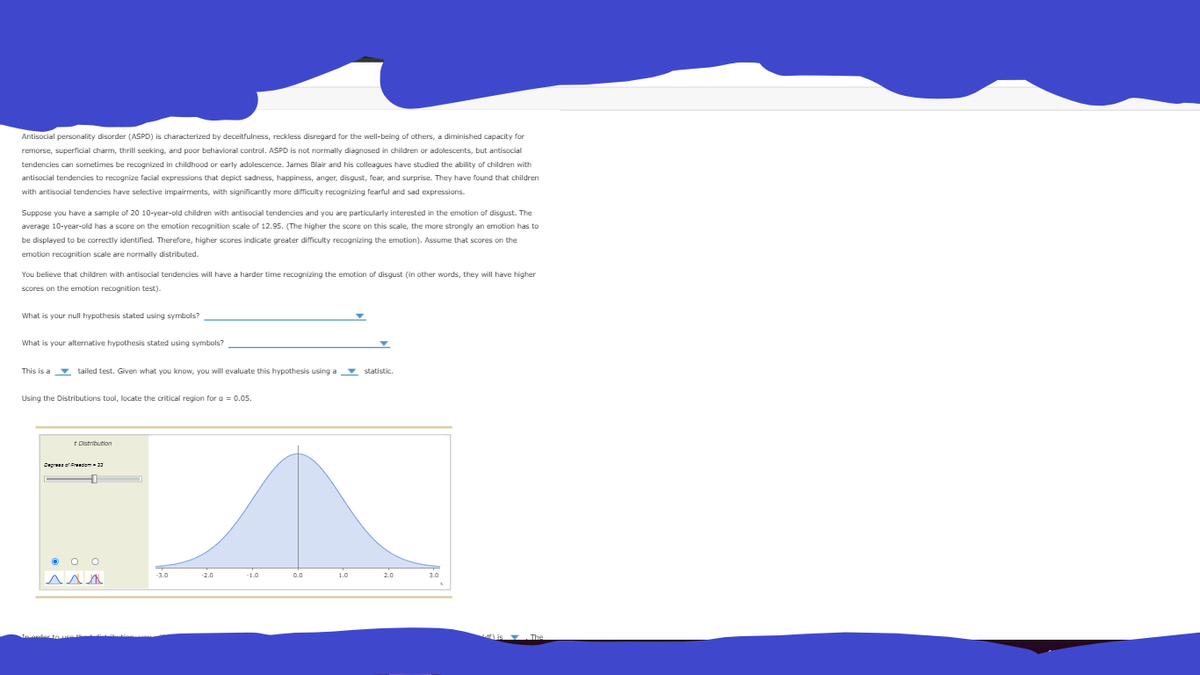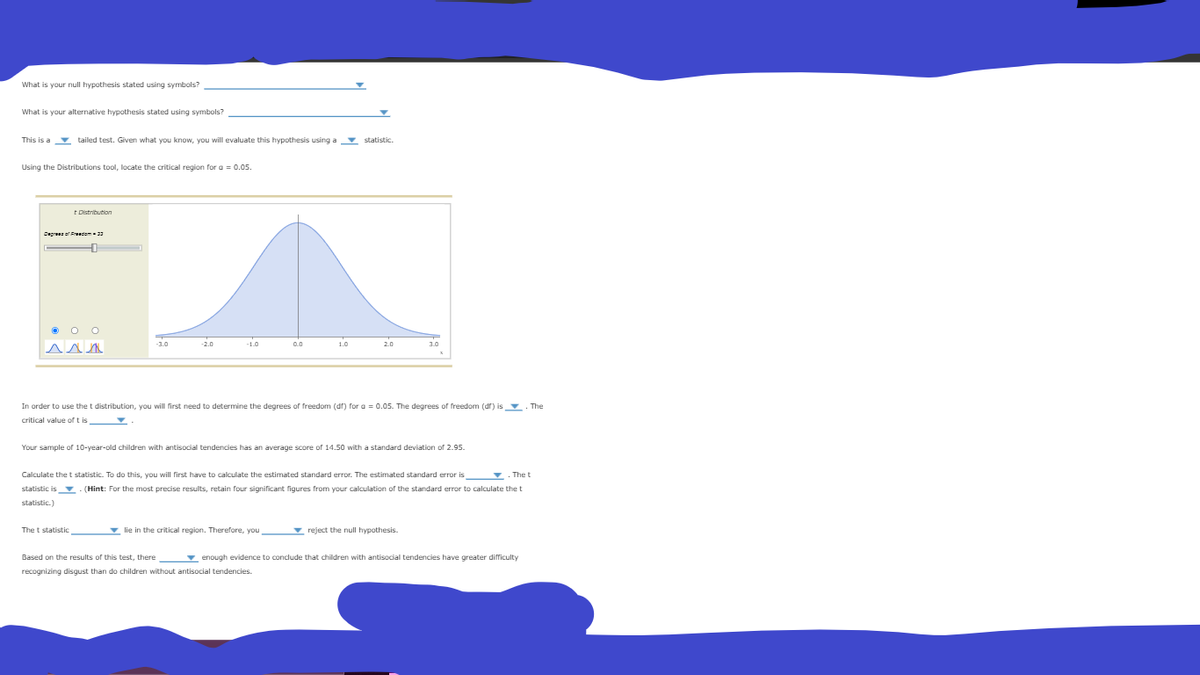Antisocial personality disorder (ASPO) is characterized by deceitfulness, reckless disregard for the well-being of others, a diminished capacity for remorse, superficial charm, thrill seeking, and poor behavioral control. ASPO is not normally diagnosed in children or adolescents, but antisocial tendencies can sometimes be recognized in childhood or carly adolescence. James Blair and his colleagues have studied the ability of children with antisocial tendencies to recognize facial expressions that depict sadness, happiness, anger, disgust, fear, and surprise. They have found that children with antisocial tendencies have selective impairments, with significantly more dficulty recognizing fearful and sad expressions. Suppose you have a sample of 20 10-year-old children with antisocial tendencies and you are particularly interested in the emotion of disgust. The average 10-year-old has a score on the emotion recognition scale of 12.95. (The higher the score on this scale, the more strongly an emotion has to be displayed to be correctly identified. Therefore, higher scores indicate greater difficulty recognizing the emotion). Assume that scores on the emotion recognition scale are normally distributed. You beleve that children with antisocial tendences will have a harder time recognizing the emotion of disgust (in other words, they will have higher scores on the emotion recognition test). What is your null hypothesis stated using symbols? What is your alternative hypothesis stated using symbols? This is a tailed test. Given what you know, you will evaluate this hypothesis using a statistic. Using the Distributions tool, locate the critical region for a = 0.05. t Ditribution -3.0 -2.0 0.0 2.0 10
Antisocial personality disorder (ASPO) is characterized by deceitfulness, reckless disregard for the well-being of others, a diminished capacity for remorse, superficial charm, thrill seeking, and poor behavioral control. ASPO is not normally diagnosed in children or adolescents, but antisocial tendencies can sometimes be recognized in childhood or carly adolescence. James Blair and his colleagues have studied the ability of children with antisocial tendencies to recognize facial expressions that depict sadness, happiness, anger, disgust, fear, and surprise. They have found that children with antisocial tendencies have selective impairments, with significantly more dficulty recognizing fearful and sad expressions. Suppose you have a sample of 20 10-year-old children with antisocial tendencies and you are particularly interested in the emotion of disgust. The average 10-year-old has a score on the emotion recognition scale of 12.95. (The higher the score on this scale, the more strongly an emotion has to be displayed to be correctly identified. Therefore, higher scores indicate greater difficulty recognizing the emotion). Assume that scores on the emotion recognition scale are normally distributed. You beleve that children with antisocial tendences will have a harder time recognizing the emotion of disgust (in other words, they will have higher scores on the emotion recognition test). What is your null hypothesis stated using symbols? What is your alternative hypothesis stated using symbols? This is a tailed test. Given what you know, you will evaluate this hypothesis using a statistic. Using the Distributions tool, locate the critical region for a = 0.05. t Ditribution -3.0 -2.0 0.0 2.0 10
College Algebra (MindTap Course List)
12th Edition
ISBN:9781305652231
Author:R. David Gustafson, Jeff Hughes
Publisher:R. David Gustafson, Jeff Hughes
Chapter8: Sequences, Series, And Probability
Section8.7: Probability
Problem 58E: What is meant by the sample space of an experiment?
Related questions
Question
fill all the blanks according to the sentences

Transcribed Image Text:Antisocial personality disorder (ASPD) is characterized by deceitfulness, reckless disregard for the well-being of others, a diminished capacity for
remorse, superficial charm, thrill seeking, and poor behavioral control. ASPD is not normally diagnosed in children or adolescents, but antisocial
tendencies can sometimes
recognized in childhood or early adolescence. James Blair and his colleagues have studied the ability of children with
antisocial tendencies to recognize facial expressions that depict sadness, happiness, anger, disgust, fear, and surprise. They have found that children
with antisocial tendencies have selective impairments, with significantly more difficulty recognizing fearful and sad expressions.
Suppose you have a sample of 20 10-year-old children with antisocial tendencies and you are particularly interested in the emotion of disgust. The
average 10-year-old has a score on the emotion recognition scale of 12.95. (The higher the score on this scale, the more strongly an emotion has to
be displayed to be correctly identified. Therefore, higher scores indicate greater difficulty recognizing the emotion). Assume that scores e
the
emotion recognition scale are normally distributed.
You believe that children with antisocial tendencies will have a harder time recognizing the emotion of disgust (in other words, they will have higher
scores on the emotion recognition test).
What is your null hypothesis stated using symbols?
What is your alternative hypothesis stated using symbols?
This is a tailed test. Given what you know, you will evaluate this hypothesis using a - statistic.
Using the Distributions tool, locate the critical region for a = 0.05.
t Distribution
Cegrea o Freedom 23
-1.0
1.0
0.0
2.0

Transcribed Image Text:What is your null hypothesis stated using symbols?
What is your alternative hypothesis stated using symbols?
This is a tailed test. Given what you know, you will evaluate this hypothesis using a v statistic.
Using the Distributions tool, locate the critical region for a = 0.05.
t Distribution
Cegre e Freedom 23
-3.0
-2.0
-1.0
0.0
1.0
2.0
3.0
first need to determine the degrees of freedom (dr) for a = 0.05.
degrees e
to use the t
you
lom (dr) is . The
critical value of t is
Your sample of 10-year-old children with antisocial tendencies has an average score of 14.50 with a standard deviation of 2.95.
Calculate thet statistic. To do this, you will first have to calculate the estimated standard error. The estimated standard error is
v. The t
statistic is . (Hint: For the most precise results, retain four significant figures from your calculation of the standard error to calculate the t
statistic.)
The t statistic
v lie in the critical region. Therefore, you
v reject the null hypothesis.
Based on the results of this test, there v enough evidence to conclude that children with antisocial tendencies have greater difficulty
recognizing disgust than do children without antisocial tendencies.
Expert Solution
This question has been solved!
Explore an expertly crafted, step-by-step solution for a thorough understanding of key concepts.
This is a popular solution!
Trending now
This is a popular solution!
Step by step
Solved in 2 steps with 1 images

Recommended textbooks for you

College Algebra (MindTap Course List)
Algebra
ISBN:
9781305652231
Author:
R. David Gustafson, Jeff Hughes
Publisher:
Cengage Learning

College Algebra (MindTap Course List)
Algebra
ISBN:
9781305652231
Author:
R. David Gustafson, Jeff Hughes
Publisher:
Cengage Learning